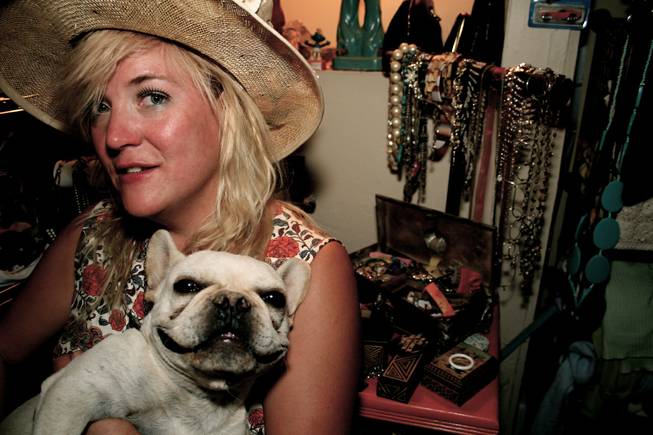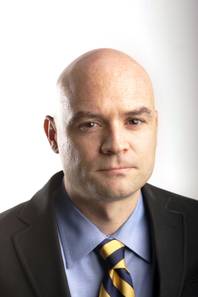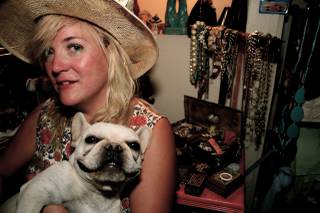
Carly Pribyl Lockman / Courtesy
Clarissa Engstrom poses for a photo essay by Carly Pribyl Lockman.
Monday, May 21, 2012 | 2 a.m.
View more of the Sun's opinion section

J. Patrick Coolican
To get help
If you or someone you know may be contemplating suicide, call the National Suicide Prevention Lifeline at 800-273-8255 or the
Veterans Crisis Line at 800-273-8255 and press 1.
When Dr. Clarissa Engstrom died, they came from all over America, like pilgrims offering tribute to a healer. And for many, that’s what she was. As a veterinarian, she treated and cured their animals, but she also treated the soul sickness that afflicts many humans.
“I was instantly enamored by her presence,” said John Talley, who came from Florida for one of the memorial services here. When he met Engstrom, known to friends as “Gooey,” Talley was struggling to come out as a gay man and found himself alienated from family. “She said, ‘You’re amazing, and don’t let anyone tell you anything different.’ ” With her inspiration, he says, he would go on to become an equestrian trainer. “I wouldn’t be where I am today if she hadn’t told me to go, go, go.”
Other friends, spanning diverse subcultures — including animal lovers, food aficionados, and art and Burning Man enthusiasts — tell similar stories of inspiration and support that was both material and emotional.
Her death is all the more tragic because it may have been preventable.
She was arrested for driving under the influence and booked into the Clark County Detention Center on March 3 after an accident on State Route 159 in which she injured a cyclist, according to the official arrest report.
I don’t wish to minimize Engstrom’s grievous error in judgment. Engstrom was, like the rest of us, imperfect, with flaws she seems to have hidden from some loved ones. I could not locate the cyclist, though I’m told the injuries were not life-threatening.
At the jail, Engstrom was deeply distraught and placed on “suicide watch.”
Metro Police spokesman Officer Jose Hernandez explained the jail’s procedures. If police believe a person might harm herself, the jail psychiatrist evaluates the inmate and can recommend suicide watch. In that case, the inmate is watched until placed in a cell, at which point the person is checked every two to four minutes. The psychiatrist will complete another evaluation during every day of custody. If still on suicide watch upon release, the person is evaluated again, and if the psychiatrist believes the person is still a threat to herself, police can exercise what’s called a “Legal 2000,” a legal protocol that allows them to commit the person to medical care.
Hernandez emphasized that both on the streets and in the jail, Metro takes mental illness seriously and has developed progressive procedures for dealing with suicide and untreated mental illness in the Las Vegas Valley, most notably through its Crisis Intervention Team.
Engstrom was evaluated again on March 4, and on the basis of that evaluation, she was taken off suicide watch. That meant she would continue to be monitored, but not as closely, Hernandez said.
Sun coverage
Metro denied a Sun public records request for the psychiatric evaluations, citing federal health privacy law.
Engstrom contacted a bail bondsman and was released early on the morning of March 5. Because she was not on suicide watch, she was not evaluated before release.
People close to Engstrom were alerted to the suicide risks secondhand, but ultimately, they were ill-prepared to deal with a person contemplating suicide.
Engstrom took her own life with pentobarbital three days later. She was 44.
Naturally, friends question whether Metro took all possible precautions before releasing her.
Linda Flatt of the Nevada Office of Suicide Prevention cautioned against finger pointing. “People can put on a good face,” she said, meaning they can hide their suicidal intentions. “Police will often go out on a welfare check because someone is concerned, they get to the house, and the person says, ‘I’m fine,’ but they’re not. These things are very complicated.”
Flatt also points to two obstacles to suicide prevention: “The public is not educated in how to deal with suicide risk. And then there’s the issue of limited resources.”
Nevada’s suicide rate is more than 50 percent above the national average, and Clark County saw more than 400 suicides in 2010, a number that has risen since the recession. If they were homicides instead of suicides, we’d have nearly the worst murder rate in America. Suicide, however, draws less attention and urgency. This is unfortunate because we will miss those we are losing.
Dr. Clarissa Engstrom was born in Concord, N.C., in 1967. In an obituary that appeared in the Charlotte Observer, her father, Dr. George Engstrom, shared the incredible details of his daughter’s life: college in North Carolina. The Peace Corps in Zaire. The Jane Goodall Institute and Wildlife International, building a health care facility for infant chimps. Her tour interrupted by revolution, she escaped to Rwanda and worked on AIDS prevention. Languages: Swahili, African French as well as tribal dialects.
After work at the Smithsonian Institution’s National Museum of Natural History, Engstrom went to North Carolina State University’s College of Veterinary Medicine. She won a Rotary Foundation Ambassadorial Scholarship to Edinburgh, Scotland, followed by field research with diseased donkeys in Lahore, Pakistan.
She came to Las Vegas to practice veterinary medicine in 2002 and became well known for her diagnostic prowess and bedside manner.
“Compassion and passion,” said Kathy Meisler, executive director of the Las Vegas Kennel Club Association, which was Engstrom’s nonprofit to promote spay and neutering.
A close friend described first meeting Engstrom. After she made an exquisite meal, she pulled out a basket of 13 apparently orphaned kittens and fed them by hand. She then went to the restroom to stimulate them so they could perform the necessary bodily function.
Humans were just as likely to be the recipients of her compassion.
“Gooey is the first one to be on the front lines to help any living creature,” the friend said.
Admirers say she also had a seemingly inexhaustible energy to wring every drop out of the soaked tapestry of life — every day a chance for a spontaneous trip, new friends, new food, new art. “You only had to meet her one time to remember her the rest of your life,” Meisler said.
She was the person who showed up unexpectedly at the party with the perfect dessert that you didn’t know you needed until she appeared. Or saw the perfect thrift shop dress and bought it for a long-lost friend. She shopped at yard sales and thrift stores because she gave much away. She was conflicted about taking money for her veterinary care.
She’d lately found what she believed was her true calling, which she called “Heaven at Home.” She would travel to people’s homes to help them say goodbye to their dying pets before administering euthanasia.
Her father is a retired pediatrician who always knew parents never got over the death of a child, but now he feels this with wrenching intimacy. The family takes comfort in all those Clarissa touched, he said. “I’m just amazed at what people said about her," he said. "‘She changed my life,’ or, ‘She helped me when I needed it.' I thought, ‘Well, it was a short life, but while she was here she changed the lives of some people because she was here. Not many of us can say that.”
For friends and family, the what-ifs, the whys and the unanswered questions overwhelm.
They hope to mobilize efforts against suicide and to reach those affected by it.


Join the Discussion:
Check this out for a full explanation of our conversion to the LiveFyre commenting system and instructions on how to sign up for an account.
Full comments policy